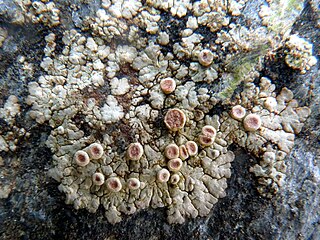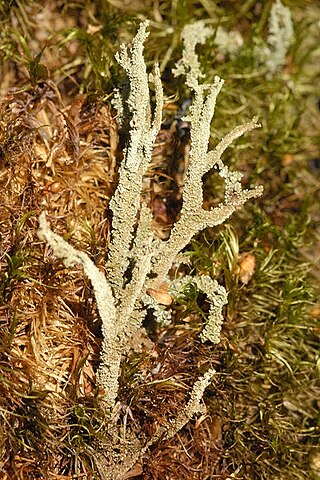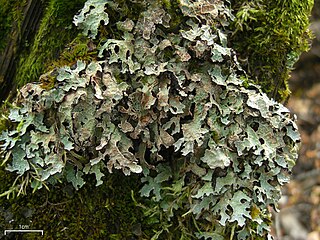
Placopsis is a genus of lichenized fungi in the family Trapeliaceae.

Imshaugia is a genus of seven species of foliose lichens in the family Parmeliaceae. They are commonly known as starburst lichens.
Aderkomyces thailandicus is a species of corticolous (bark-dwelling), crustose lichen in the family Gomphillaceae. Found in the lower montane rainforests of Thailand, it was described as new to science in 2011.
Diorygma microsporum is a species of corticolous (bark-dwelling) crustose lichen in the family Graphidaceae. It was described as new to science in 2011. It has a neotropical distribution, and has been collected in Florida, Colombia, Brazil, and India. Notable for its small ascospores, this lichen thrives in undisturbed rainforests and serves as an indicator of forest health.
Parmelia asiatica is a species of corticolous (bark-dwelling) foliose lichen in the family Parmeliaceae. It occurs in China and the Russian Far East, where it grows on Rhododendron tree trunks in temperate regions. It was Described as new to science in 2011 by lichenologists Ana Crespo and Pradeep Divakar. The species is distinguished by its terminal soralia, marginal linear pseudocyphellae, and chemical composition, which includes the substances atranorin and salazinic acid. Parmelia asiatica is similar to Parmelia protosulcata but differs in the presence of salazinic acid and its distribution in Southeast Asia.
Teuvoa is a genus of lichen-forming fungi in the family Megasporaceae. It was first classified by lichenologists Mohammad Sohrabi and Steven Leavitt in 2013, with Teuvoa uxoris asigned as the type species. This genus was delineated from the larger genus, Aspicilia, following a molecular phylogenetic analysis which revealed that the Aspicilia uxoris species group constituted a distinct lineage in the Megasporaceae. Initially containing three species, two additional species native to China were added in 2018. Teuvoa is characterised by its small ascospores and conidia, and the absence of secondary metabolites.
Punctelia negata is a little-known species of foliose lichen in the family Parmeliaceae. It is found in South America.
Punctelia riograndensis is a species of foliose lichen in the family Parmeliaceae. Found in Africa and South America, it was formally described as a new species by Norwegian lichenologist Bernt Lynge in 1914, as Parmelia riograndensis. The type specimen was collected in 1892 from Porto Alegre Municipality in Rio Grande do Sul State (Brazil) by Swedish lichenologist Gustav Malme. In 1982, Hildur Krog circumscribed the genus Punctelia to contain Parmelia species with rounded pseudocyphellae, and P. riograndensis was one of the 22 species that she transferred to the new genus.
Punctelia subalbicans is a species of foliose lichen in the family Parmeliaceae. It is found in Australia and New Zealand, where it grows on the bark of various tree species.
Punctelia jujensis is a species of foliose lichen in the family Parmeliaceae. It is found in Argentina and Brazil.

Cladonia squamosa or the dragon cup lichen is a species of cup lichen in the family Cladoniaceae.
Punctelia colombiana is a species of corticolous (bark-dwelling) and foliose (leafy) lichen in the family Parmeliaceae. It is found in South America.
Punctelia subpraesignis is a species of foliose lichen in the family Parmeliaceae. It occurs in Mexico, South America, and East Africa, where it grows on bark and on rocks. Major characteristics of the lichen that distinguish it from other Punctelia species include the C+ and KC+ rose spot tests of the medulla, ascospores that are smaller than 20 μm, and unciform (hooklike) conidia.

Punctelia perreticulata is a widely distributed species of foliose lichen in the family Parmeliaceae. It occurs in Mediterranean Europe and Russia, North America, South America, Australia, and New Zealand, where it grows on rocks, bark, or wood. Its main distinguishing features are its thallus surface, marked with many shallow depressions, grooves, or pits, and sorediate pseudocyphellae. The lower side of the thallus is ivory to tan towards the centre and the major secondary metabolite in the medulla is lecanoric acid. A lookalike species with which it has been historically confused is Punctelia subrudecta; this lichen can be distinguished from Punctelia perreticulata by the texture of the thallus surface, or, more reliably, by the length of its conidia.

Punctelia graminicola is a species of foliose (leafy) lichen in the family Parmeliaceae. It grows on rocks, and, less frequently, on bark in North America, South America, and East Africa. It has a blue-grey thallus measuring up to about 15 cm (6 in), covered with tiny pores called pseudocyphellae. Sometimes the lichen forms small lobes that project out from the surface. Fruiting bodies are uncommon in this species; if present, they resemble small cups with a brown internal disc measuring 3–10 mm (0.1–0.4 in) in diameter. A lookalike species, Punctelia hypoleucites, is not readily distinguishable from Punctelia graminicola by appearance or habitat alone; these species can only be reliably differentiated by examining the length of their conidia.

Punctelia stictica is a species of foliose lichen in the family Parmeliaceae. It is widely distributed lichen, recorded in Africa, Europe, North America, South America, and Greenland. It is typically found growing on rocks.
Parmelia protosignifera is a species of foliose lichen in the large family Parmeliaceae. Found in Australasia, it was described as a new species in 1988 by lichenologists John Elix and Jen Johnston. The type specimen was collected on sheltered granite ledges in Eucalyptus woodland on the eastern slopes on Tinderry Peak in New South Wales. It has also been collected in Victoria, as well as South Island and Stewart Island of New Zealand.

Parmelia barrenoae is a species of foliose lichen in the large family Parmeliaceae. It was formally described as a new species in 2005. Before this, it was lumped together as one of several lichens in the Parmelia sulcata group—a species complex of genetically distinct lookalikes. Parmelia barrenoae is widely distributed, occurring in Europe, western North America, Africa, and Asia.
Leucodecton canescens is a species of lichen in the family Graphidaceae. Found in Sri Lanka, it was formally described as a new species in 2014 by lichenologists Gothamie Weerakoon, Robert Lücking and Helge Thorsten Lumbsch. The type specimen was collected from the Maussakanda Tea Estate at an altitude of 1,074 m (3,524 ft). The lichen, which has been recorded from several locations in the Central Province, grows in semi-exposed, disturbed areas at high elevations. The specific epithet canescens refers to the grey-coloured cover of the thallus.
Calopadia saxicola is a species of saxicolous (rock-dwelling) crustose lichen in the family Pilocarpaceae. It is found on the rocky shores of southern Brazil, where it thrives in the shade of vegetated zones and grows directly on rocks away from other crustose lichens. The lichen was formally described as a new species in 2015. Calopadia saxicola stands out from its close relatives due to its well-defined thallus, reddish-brown disc, thicker hymenium, and smaller conidia.






